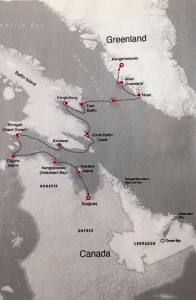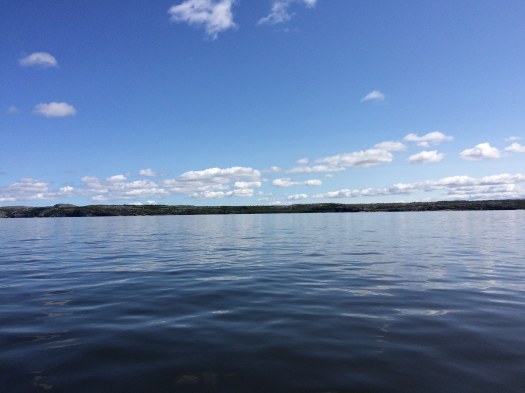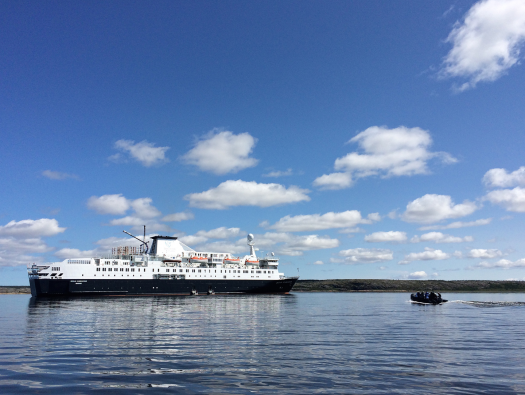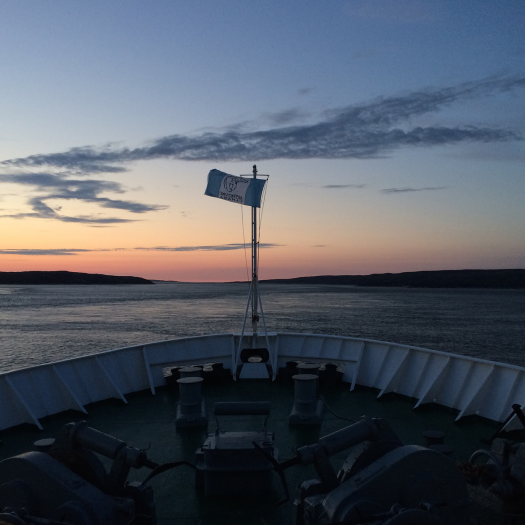A Placemaking Journal
Kuujjuaq: Heart of the Arctic Day 1
Friday, July 17, 2015
Launching Adventure Canada’s Heart of the Arctic expedition, we left Ottawa at dawn by charter flight, landing in Kuujjuaq before lunch. One glance out the window of the plane reinforces that “open space” has a whole new meaning here.
Instead of exploring the village, we headed straight for our ship, the Ocean Endeavour, launching by zodiac water craft before the tide in the mighty Koksoak River lowered. The people of Kuujjuaq are used to the river setting the rhythms of summer life, as it sculpts and changes the landscape. At just over 2,000 residents, this is Nunavik’s largest community. Not above the treeline yet, the boreal forest offers up black spruce and larch.
Kuujjauq used to be called Fort Chimo, harkening back to the early fur trade. The Hudson’s Bay Company established a fur trading post in 1830 just downstream from today’s settlement, where the US Air Force Base, Crystal 1, was built in 1942. After WWII, the US turned the base over to Canada, at which time a Catholic mission, nursing station, school and weather station began the makings of today’s village. Unusual for the Arctic, the village rocks two airstrips, hotels, restaurants, shops, and a bank.
My placemaking lessons came later in the day, at the welcoming ceremony. “Welcome” in Inuktitut translated literally means, “Please feel like you’re on solid ground.” Filmmaker John Houston opened the expedition with sharing, accompanied by traditional singing, drumming, and lamp lighting by Inuit leaders Aaju Peter, Pootoogook Qiatsuk, and Heidi Langille. They went on to share the following ideas, all on which were though-provoking in relation to the process of community engagement.
“Inuit (translated literally means, ‘The People’) make you feel like you have a foundation, and they gently, gently guide,” Aaju Peter shared with us. “As a visitor, you must accept the Inuit welcome. Half of the responsibility of the welcome rests with the newcomer. It is what you bring to the community that counts, and what you are willing to receive. The more welcoming we are, the more the land will welcome us. Welcome is a combination of gratitude and respect. The mind is so powerful, the body is like a feather being blown in the tundra.”
“The more welcoming we are, it shows our gratitude to our land, to our environment, to the sun, to the waters. It isn’t about putting up barriers between people and cultures, but about taking down barriers. By being welcoming, sharing and hospitable.”
Aaju joked, “The arctic willow is our tallest tree. If you get lost in the woods, we say, ‘Just stand up!’”
“Even when we come from different regions, the Inuit always welcome you,” celebrated Pootoogook, originally from Cape Dorset, and now an Iqualiuit resident.
John Houston shared many stories, and encouraged us to engage, “We are not here for very long. Connecting with others will give us a story to last a lifetime. Never turn down a chance to share a story with an elder.”
Aaju chimed in, “Elders are not the same as old people. Elders have knowledge they are willing to share.” She then sang a song in Inuktitut celebrating resilience, which very loosely translates into:
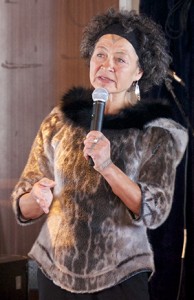
When there is no food
To feed the family
And no oil to light
The heat lamp
And the only footsteps
In the snow that I see
Are my own
I must find a song.
“When we understand the hardship someone has lived through, only then can we hear the beauty of their song of resilience,” Aaju shared. “This is a huge country. We have experienced starvation here. This is a people that have not only survived, but have done it with humor and laughter. And have formed a new state, without shedding a drop of blood.”
Coming to the Arctic by sea has its own special magic. It signals we have more time to listen. More time to look. More time to share.
One man on board, writer, actor, and environmentalist C.W. Nicol, celebrated his 75th birthday today, but this isn’t his first trip to the Arctic. He came here at 17 and has returned many times, so often the Inuit have renamed him, “The One Who Comes Back.” I’m rather certain that most of us aspire to that name, and to deeply understand any community, it may be an essential.
Anchors aweigh happened during dinner, and the midnight sunset came a bit early, since we are after solstice, lasting until about 11 p.m. The long pink rays highlighted the last we’ll see of the treeline. We headed for bed while the ship headed north up the Koksoak River toward Ungava Bay, to sleep and dream of murres and polar bears.
To read the entire Heart of the Arctic series, go here.
–Hazel Borys
If PlaceShakers is our soapbox, our Facebook page is where we step down, grab a drink and enjoy a little conversation. Looking for a heads-up on the latest community-building news and perspective from around the web? Click through and “Like” us and we’ll keep you in the loop.









